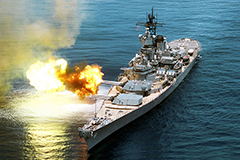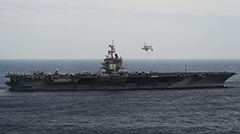1. Battleships History:
A battleship is a large armored warship with a main battery consisting of large caliber guns. During the late 19th and early 20th centuries the battleship was the most powerful type of warship, and a fleet of battleships was considered vital for any nation that desired to maintain command of the sea. The word battleship was coined around 1794 and is a contraction of the phrase line-of-battle ship, the dominant wooden warship during the Age of Sail. The term came into formal use in the late 1880s to describe a type of ironclad warship, now referred to by historians as pre-dreadnought battleships. More details
2. Cruisers History:3. Nimitz Class Aircraft Carrier:
5. Aircraft Carriers of World War II:
6. Charles de Gaulle Aircraft Carrier:
Charles de Gaulle (R91) is the flagship of the French Navy (Marine Nationale) and the largest Western European warship. She is the tenth French aircraft carrier, the first French nuclear-powered surface vessel, and the first and so far only nuclear-powered carrier completed outside of the United States Navy. It is named after French statesman and general Charles de Gaulle. The ship carries a complement of Dassault-Breguet Super Étendard, Dassault Rafale M and E‑2C Hawkeye aircraft, EC725 Caracal and AS532 Cougar helicopter for combat search and rescue, as well as modern electronics and Aster missiles. More details
7. Higgins Boat:
The landing craft, vehicle, personnel (LCVP) or Higgins boat was a landing craft used extensively in amphibious landings in World War II. The craft was designed by Andrew Higgins based on boats made for operating in swamps and marshes. More than 23,358 were built, by Higgins Industries and licensees. Typically constructed from plywood, this shallow-draft, barge-like boat could ferry a roughly platoon-sized complement of 36 men to shore at 9 knots (17 km/h). Men generally entered the boat by climbing down a cargo net hung from the side of their troop transport; they exited by charging down the boat's lowered bow ramp. More details
8. Aircraft Carriers History:
9. USS America (LHA-6) Aircraft Carrier:
USS America (LHA-6), the fourth American warship to be named for the United States of America, is the first of the America-class amphibious assault ships for the U.S. Navy. She was delivered in spring of 2014, replacing Peleliu of the Tarawa class. Her mission is to act as the flagship of an expeditionary strike group or amphibious ready group, carrying part of a Marine expeditionary unit into battle and putting them ashore with helicopters and V-22 Osprey tilt-rotor aircraft, supported by F-35B Lightning II aircraft and helicopter gunships. More details
USS Forrestal (CV-59), was a supercarrier named after the first Secretary of Defense James Forrestal. Commissioned in 1955, she was the first completed supercarrier, and was the lead ship of her class. Unlike the successor Nimitz class, Forrestal and her class were conventionally powered. The other carriers of her class were USS Saratoga, USS Ranger and USS Independence. She surpassed the World War II Japanese carrier Shinano as the largest carrier yet built, and was the first designed to support jet aircraft. The ship was affectionately called "The FID", because her namesake was the first Secretary of Defense, FID standing for "First In Defense". More details
11. Juan Carlos I (L61) Aircraft Carrier:
12. USS Enterprise Aircraft Carrier:
USS Enterprise (CVN-65), is a decommissioned United States Navy aircraft carrier. She was the world's first nuclear-powered aircraft carrier and the eighth United States naval vessel to bear the name. Like her predecessor of World War II fame, she is nicknamed "Big E". At 1,123 ft (342 m), USS Enterprise is the world's longest naval vessel ever built. Her 93,284-long-ton (94,781 tonnes) displacement ranks her as the 12th-heaviest carrier, after the 10 carriers of the Nimitz class and the USS Gerald R. Ford. Enterprise had a crew of some 4,600 service members. More details
13. Liaoning Aircraft Carrier:
Liaoning is the first aircraft carrier commissioned into the People's Liberation Army Navy Surface Force in China. It is classified as a training ship, intended to allow the Navy to experiment and gain familiarity with aircraft carrier operations. Liaoning aircraft carrier originally laid down in 1985 for the Soviet Navy as the Kuznetsov-class aircraft cruiser Riga, she was launched on December 4, 1988 and renamed Varyag in 1990. After the dissolution of the Soviet Union in 1991, construction was halted and the ship was put up for sale. The stripped hulk was purchased in 1998 and towed to the Dalian naval shipyard in northeast China. More details
14. Battleship Yamato:
Yamato was the lead ship of her class of battleships built for the Imperial Japanese Navy (IJN) shortly before World War II. She and her sister ship, Musashi, were the heaviest and most powerfully armed battleships ever constructed, displacing 72,800 tonnes at full load and armed with nine 46 cm (18.1 in) Type 94 main guns, which were the largest guns ever mounted on a warship. Named after the ancient Japanese Yamato Province, Yamato was designed to counter the numerically superior battleship fleet of the United States, Japan's main rival in the Pacific. More details
15. Battleship USS Iowa:
USS Iowa (BB-61) is a retired battleship, the lead ship of its class, and the fourth in the United States Navy to be named after the state of Iowa. Owing to the cancellation of the Montana-class battleships, Iowa is the last lead ship of any class of United States battleships and was the only ship of its class to have served in the Atlantic Ocean during World War II. During World War II, it carried President Franklin D. Roosevelt across the Atlantic to Mers El Kébir, Algeria, en route to a meeting of vital importance in 1943 in Tehran with Prime Minister Winston Churchill of Britain and Joseph Stalin, leader of the Soviet Union. More details
16. Kirov Class Battle Cruiser:
The Kirov class, Soviet designation Project 1144 Orlan (sea eagle), is a class of nuclear-powered guided missile cruisers of the Soviet Navy and Russian Navy, the largest and heaviest surface combatant warships (i.e. not an aircraft carrier or amphibious assault ship) in operation in the world. Among modern warships, they are second in size only to large aircraft carriers, and of similar size to a World War II era battleship. The ships are often referred to as battlecruisers by Western defence commentators due to their size and general appearance. More details
17. HMS Belfast Cruiser:
HMS Belfast is a Town-class light cruiser that was built for the Royal Navy. She is now permanently moored as a museum ship on the River Thames in London and is operated by the Imperial War Museum. Construction of Belfast, the first ship in the Royal Navy to be named after the capital city of Northern Ireland and one of ten Town-class cruisers, began in December 1936. She was launched on St Patrick's Day 1938. Commissioned in early August 1939 shortly before the outbreak of the Second World War, Belfast was initially part of the British naval blockade against Germany. More details
18. HSwMS Småland Destroyer:
HSwMS Småland (J19) is a Swedish Halland-class destroyer. She and HSwMS Halland were the only ones built of their class. Two more ships were ordered but they were never completed. She was decommissioned in 1979, and since 1987 has been a museum ship at Maritiman in Gothenburg, where she is the largest vessel on display. Småland was 121 meters long and 12.6 meters wide. The hull was designed with a forecastle. From the forecastle and astern, a long superstructure appeared, which made it possible for the crew to reach the entire ship without having to go outdoors, thus minimizing the risk of exposure to radioactive contamination. More details
19. Battleship USS North Carolina:
USS North Carolina (BB-55) is the lead ship of the North Carolina class of fast battleships, the first vessel of the type built for the United States Navy. Built under the Washington Treaty system, North Carolina's design was limited in displacement and armament, though the United States used a clause in the Second London Naval Treaty to increase the main battery from the original armament of twelve 14-inch (360 mm) guns to nine 16 in (410 mm) guns. The ship was laid down in 1937 and completed in April 1941, while the United States was still neutral during World War II. During this period, she operated off the eastern coast of the United States. More details
20. Maillé-Brézé Destroyer:
Maillé-Brézé is a T 47-class destroyer (escorteur d'escadre) of the French Navy. She was built by Arsenal de Lorient in Lorient, commissioned on 4 May 1957 and named after the French admiral Jean Armand de Maillé-Brézé (1619–1646). On 2 March 1962, Maillé-Brézé, along with another four destroyers, landed fresh troops at Algiers to fight the OAS upsurge. Assisted by her sister ship Surcouf, she was about to shell the OAS-held quarter of Bab-el-Oued when a counter-order called the operation off. The destroyers instead took battle stations close to the shore as a deterrent. In 1988 she was decommissioned and became a museum ship in Nantes. More details











+Aircraft+Carrier+Subnail.jpg)








